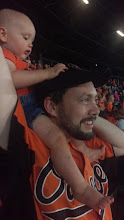Here we are at last...the end of the road. One last time, I would like to thank everyone who has read, shared, or commented on this blog over the last five years and change. I didn't post these entries on anything resembling a consistent schedule, so it means a lot to me that you hung in there and offered feedback and kind words. An even bigger thanks goes to all who helped me accomplish something that started off as a pipe dream: collecting a complete set of cards that predates me by 17 years. At the outset, I assumed that I might be able to cobble together a fair share of 1965 Topps through some overly-generous trades, but I was pleasantly surprised by how many of you were willing to help - and how much you were willing to help! I never imagined that some of you folks would be glad to send along cards without even expecting anything in return. I hope that my gratitude and my few words about those cards will suffice in some small way.
I had a lot of fun in completing my first vintage set completely from scratch, and I'd like to think that the information I acquired in researching these players helped to make me a better baseball fan. As I went along in this process, I made some significant changes in the way I presented the cards I'd acquired. I started off presenting both sides of the various trades in a summary-style post, and didn't offer much detail on the players featured. Later I focused on each new card individually, with full player biographies in multiple-paragraph form. That became a bit tedious and cumbersome, so I switched to the bullet-point presentation that I still use today. As I drew closer to completing the set, I considered re-posting all of the early cards with new bullet-point formats, for consistency's sake. But ultimately, I decided to leave the blog as-is. I think it helps illustrate the changing process that I used to complete and appreciate the 1965 Topps set. I'd also like to announce the pending launch of STILL ANOTHER card blog, because I am a glutton for punishment. This time it's a set I've already completed, and one that dates back to the very onset of my fandom: the 1993 Topps base set. If you've got room on your blogroll for one more set blog, hold on to that link. I'm really looking forward to spending the next few years revisiting the cards that consumed much of my attention 20 years ago. I'm hoping to update over there on a near-daily basis, but we'll see what the future holds. Now then...on with the final card of 1965!
It's fitting in a way that Eddie Bressoud takes us home, since I don't know the first thing about him. In what is likely my very last update to the 1965 Topps blog, I am going to learn about a player who has escaped my attention thus far.
Fun facts about Eddie Bressoud:
-A native Los Angeleno, Eddie signed with the New York Giants as a teenager in 1950.
-He served in the military during the 1953 and 1954 seasons, delaying his big league debut until 1956. In his initial game on June 14, Bressoud had the unenviable task of facing future Cooperstown resident Warren Spahn. The young infielder went hitless in his first three tries, but ultimately notched a single against Spahn in the eighth inning.
-In a half-dozen seasons with the Giants, Eddie averaged only 74 games a year with a below-average batting line of .239/.299/.369. But the Houston club made him their first pick in the October 1961 expansion draft and flipped him to the Red Sox a month later for shortstop Don Buddin. It proved to be a lopsided deal, as Buddin hit .163 in 40 games for the Colts and was out of the majors by season's end; Bressoud, meanwhile, found Boston much to his liking.
-Bressoud rapped 40 doubles for the Sox in 1962, as well as nine triples, 14 home runs, and 68 RBI. His triples and RBI totals would be career highs.
-Eddie reached the 20-homer plateau for the only time in his career in 1963. Highlights included four two-homer games, his only career walk-off shot (June 26 against Pedro Ramos of the Indians), and his first career grand slam (August 22 against Chicago's Taylor Phillips).
-1964 was a career year for Bressoud, as he batted .293/.372/.456 with 41 doubles and made his only All-Star team.
-He declined sharply after that, with an OPS dip of 180 points the next season. Boston traded the shortstop to the Mets for the 1966 campaign, and he lasted one year in New York before finishing his career as a reserve for the World Champion Cardinals squad in 1967. Eddie appeared in two World Series games as a late-inning defensive replacement, a low-key farewell for the 12-year major league veteran.
-His career batting line was .252/.319/.401 with 94 home runs and 365 RBI.
-Following his playing career, Bressoud earned his college degree from UCLA. He also spent two seasons managing in the minors for the Angels, and was a scout for the Halos for a time. Later he taught physical education and coached the baseball team at De Anza College in Cupertino, CA.
-Eddie still lives in San Ramon, CA. He celebrated his 81st birthday a week ago.
Friday, May 10, 2013
Wednesday, May 08, 2013
#484 Ron Perranoski
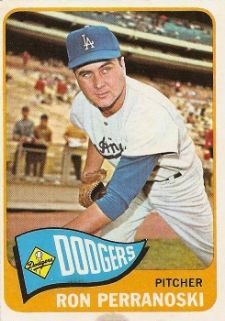
Fun facts about Ron Perranoski:
-Ron was born in Paterson, NJ (as Ron Perzanowski) and attended Michigan State University before signing with the Cubs in 1958.
-His cousin, Stan Perzanowski, pitched in 37 games for the White Sox, Rangers, and Twins between 1971 and 1978.
-The Cubs traded him to the Dodgers in April 1960 as part of a three-for-one deal that sent Don Zimmer to Chicago. He debuted with L.A. a year later and was a bullpen fixture from the start, appearing in 53 games with a 7-5 record, six saves, and a 2.65 ERA.
-1963 was Perranoski's standout season, as he posted a 16-3 record in relief with 21 saves and a 1.67 ERA. He paced the National League in winning percentage (.842) and games pitched (69), and finished fourth in MVP balloting. In the Dodgers' World Series sweep over the Yankees, the lefty nailed down a save in Game Two by getting the final two outs in relief of Johnny Podres.
-As you might imagine, the career-long reliever wasn't much of a hitter. In 190 career plate appearances, he had a batting line of .096/.147/.114 with three RBI. However, he did hit a triple on September 4, 1966 off of the Reds' Don Nottebart. I would've liked to have seen him run the bases!
-In all, Ron spent eight years in Los Angeles, posting a 54-41 record, 101 saves, and a 2.56 ERA.
-The Twins acquired the relief ace in November 1967, parting with former A.L. MVP Zoilo Versalles and 20-game winner Jim "Mudcat" Grant and receiving Perranoski, John Roseboro, and Bob Miller.
-Ron led the American League in saves in both the 1969 and 1970 seasons, with 31 and 34 respectively. Though the Twins captured the first two Western Division crowns in A.L. history, they ran into the Baltimore juggernaut in the postseason in each year. The league's top fireman allowed a total of eight runs in seven innings as the Orioles swept Minnesota twice.
-The final three years of Ron's career saw him move from the Twins to the Tigers, then back to the Dodgers briefly, before an eight-game stint with the Angels in 1973 signaled the end of the road. In 13 seasons, he was 79-74 with 179 saves and a 2.79 ERA.
-Perranoski found a home in the Dodgers' organization after retiring as a player. He was the club's minor league pitching coordinator (1973-1980) and big league pitching coach (1981-1994) for more than two decades before joining the rival Giants in 1995. He's been with San Francisco ever since, serving as minor league pitching coordinator, major league bench coach and pitching coach, and finally as a special assistant to general manager Brian Sabean.
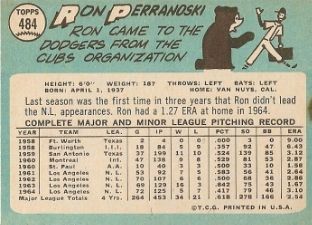
Monday, May 06, 2013
#443 Checklist 6th Series


Friday, May 03, 2013
#284 Nick Willhite
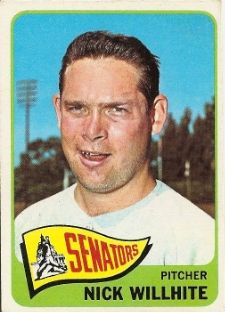
Fun Facts about Nick Willhite:
-Nick was born in Tulsa, OK, grew up in Denver, CO, and signed with the Dodgers as an 18-year-old in 1959.
-At Class A Greenville, he threw 230 innings in 1961, going 16-9 with a sparkling 1.80 ERA.
-Willhite debuted with the Dodgers in a big way, tossing a five-hit, six-strikeout shutout against the Cubs on June 16, 1963. It proved to be his only shutout in 29 career starts.
-As a hitter, it was either feast or famine for Nick, who batted .300 (3-for-10) as a rookie and .400 (4-for-10) in 1965. In the other two seasons in which he batted, the southpaw was a combined 0-for-23!
-The Senators purchased Willhite's contract from the Dodgers in October of 1964, but sold him back to L.A. the following May after he allowed 11 runs (five earned) in five relief appearances.
-Although Nick saw regular-season action for Los Angeles in their World Series-winning seasons of 1963 and 1965 and their pennant-winning season of 1966, he never appeared in a postseason game.
-He found himself out of baseball at age 26 after racking up a 5.10 ERA in a 1967 season split between the Angels and Mets. In parts of five big league seasons, he had a 6-12 record and a 4.55 ERA.
-Willhite later went into coaching, instructing pitchers at Brigham Young University as well as stints in the Brewers and Yankees farm systems.
-By the late 1980s, Nick was thrice-divorced and living on the streets of Salt Lake City. He reached out to former teammate Stan Williams, and was able to obtain treatment for drug and alcohol addictions through the Baseball Assistance Team.
-Willhite became an addictions counselor after his own successful rehabilitation. In December of 2008, he died of cancer at age 67 in his son's home in Alpine, Utah.
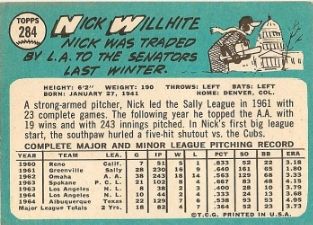
Monday, April 15, 2013
#252 Pete Richert
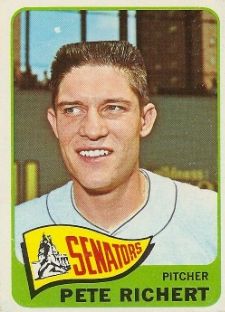
Fun facts about Pete Richert:
-A native of Floral Park, NY, Pete signed with the Dodgers as a teenager in 1958.
-He debuted with the Dodgers on April 12, 1962, earning the win with 3.1 innings of scoreless relief after starter Stan Williams was chased in the second inning. In Richert's first full inning, he set a big league record with four strikeouts, victimizing Frank Robinson, Gordy Coleman, Wally Post, and Johnny Edwards. Coleman reached base when catcher Johnny Roseboro committed a passed ball on strike three, enabling the rare feat. Overall, the rookie struck out seven and allowed no hits or walks.
-Jockeying for mound time on a staff that boasted Koufax, Drysdale, and Johnny Podres, Pete totaled 194 innings in three seasons in L.A. He posted a middling 4.18 ERA and 1.47 WHIP, then was dealt to the Senators.
-In his two full seasons in Washington, Richert made the only two All-Star teams of his career. In 1965, he led the Senators with a 15-12 record and a 2.60 ERA (fifth-lowest in the American League), and struck out 161 batters in 194 innings. In a career-high 245 innings the following year, he was again the club's best starter with a 14-14 mark and a 3.37 ERA.
-On April 24, 1966, the southpaw struck out seven straight Detroit batters and whiffed 12 overall in six innings. He also took the loss, as Bill Monbouquette tossed a shutout for the Tigers.
-The injury-plagued Orioles acquired Pete in May of 1967, and he put up a 2.99 ERA in 26 games (19 starts) for his new club. Those would be the last 19 starts of his career.
-Richert thrived with the Orioles after switching to relief full-time. In 1969, he he seven wins, a dozen saves, and a 2.20 ERA for the American League champs. He struck out 54 batters in 57.1 innings, and allowed only 56 baserunners. The next season, he was just as good if not better: 7-2, 13 saves, a 1.98 ERA, 66 strikeouts in 54.2 innings, and a 1.10 WHIP.
-Pete was unscored upon in the postseason, appearing in the 1969 ALCS and the 1969, 1970, and 1971 World Series. For whatever reason, he was also barely used, facing just nine batters total and accumulating two innings of work. But he did earn a save in the opener of the 1970 Series, replacing Jim Palmer with two outs in the ninth and the tying run on first base in the form of Pete Rose. The reliever induced a liner to shortstop off the bat of Bobby Tolan, and the stage was set for Baltimore's five-game triumph over the Reds.
-Richert finished his career with a three-year stint in the National League, returning to the Dodgers for 1972-1973 and splitting the 1974 campaign between the Cardinals and Phillies. In 13 major league seasons, he was 80-73 with 51 saves and a 3.19 ERA.
-He spent more than a decade as a minor league pitching coach in the Oakland and San Francisco organizations.
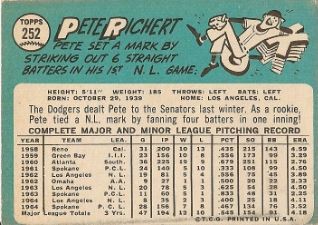
Wednesday, April 10, 2013
#246 Tom Butters
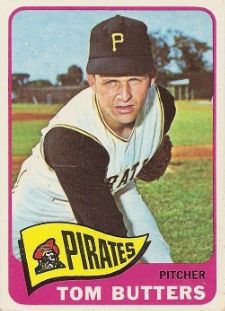
Fun facts about Tom Butters:
-Tom was born in Delaware, OH, and grew up following Lou Boudreau's successful Indians teams. He signed with the Pirates as a 17-year-old in 1957, and attended Ohio Wesleyan University for one semester each year, ultimately graduating with a degree in religion and physical education.
-He didn't reach the majors until 1962, in large part due to control issues; he walked at least 5.3 batters per nine innings in each of his first four years in pro ball.
-Butters made his big league debut on September 8, 1962 with two innings of scoreless relief against the Dodgers. He struck out three batters: opposing pitcher Pete Richert, Ron Fairly, and soon-to-be batting champ Tommy Davis. In four relief appearances that month, the rookie allowed a single run in six innings.
-He spent much of the 1964 season as a low-ranking member of the Pirate bullpen, starting four games and relieving in 24 others. He split the decisions in those four starts, going 2-2 with a solid 2.38 ERA for the year. He still wasn't very precise, striking out 58 and walking 37 in just 64.1 innings.
-While driving through Fayetteville, NC en route to spring training in 1965, Butters' car was struck from the rear by another driver. The collision caused Tom to suffer from severe whiplash, and he dealt with lingering headaches and nausea. He tried to pitch through his maladies, but gave up seven earned runs in nine innings out of the Pittsburgh 'pen and was released in midseason.
-Tom saw the writing on the wall and retired, finishing with a 2-3 record and a 3.10 ERA in parts of four major league seasons.
-He briefly took an admissions job at his alma mater before hiring on at Duke University in the development office. When the head baseball coach died suddenly, Butters was selected for that post at the suggestion of his ex-teammate (and Duke alumnus) Dick Groat. The Blue Devils had an overall record of 43-53-1 in three seasons under the former big leaguer, but were hamstrung by a lack of athletic scholarships.
-Tom's superlative fundraising efforts earned him several promotions, leading to his appointment as athletic director in 1977. His most notable achievement in that role was the 1980 hiring of Mike Krzyzewski as men's basketball coach; 33 years and four national championships later, "Coach K" is still at the school.
-Butters retired from Duke in 1998, and was elected into the university's Sports Hall of Fame a year later. The Schwartz-Butters Athletic Center, the capstone project of Tom's tenure, was dedicated in 2000.
-He still spends most of his time in Durham, NC with Lynn, his wife of more than 50 years. The couple have two children.
(The source for much of this blog post is Rory Costello's SABR biography of Tom Butters, which is rich in detail even though it tends to verge on Duke University boosterism.)

Tuesday, April 02, 2013
#196 Ron Fairly
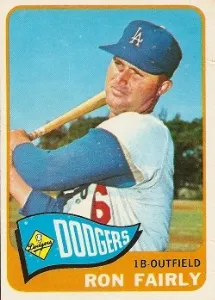
Fun facts about Ron Fairly:
-A native of Macon, GA, Ron moved to southern California at a young age and starred at USC before signing with the Dodgers for a $75,000 bonus in 1958.
-His father Carl played minor league ball for 11 seasons, roaming the infield. His best year came at Class B Macon in 1938, the year Ron was born; he batted .302 for the Peaches.
-Though still shy of his 20th birthday, Fairly was promoted to the majors after slugging .528 in only 69 minor-league games. In a 15-game trial with L.A., the youngster hit .283/.350/.415 with a pair of homers.
-A crowded Dodgers outfield and a stint in the Army Reserves slowed Ron's meteoric rise, but he batted .322/.434/.522 as a part-time player in 1961 and found a new home at first base. The following year, he led the club with a .379 on-base percentage.
-Fairly played in four World Series with the Dodgers, winning championships in 1959, 1963, and 1965 and bowing to the Orioles in 1966. In 1965, he started all seven games against the Twins and batted .379 with a .690 slugging percentage. He hit safely in 11 of 29 at-bats, homered twice, and drove in six runs. Perhaps most impressively, he struck out only once.
-A late-20's decline that Fairly attributes to a change in Dodger Stadium groundskeeping (post-Koufax, the team grew the infield grass longer, which slowed down hard ground balls) spurred Los Angeles to trade him to the Expos in June 1969. L. A. reacquired Maury Wills and Manny Mota in the deal.
-Though Ron wasn't happy playing for an expansion team far from home, his performance did rebound in Montreal. His OPS+ was 115 or greater in each of his half-dozen seasons as an Expo, and he was an All-Star for the first time in 1973. That year he had a .298 average and career highs of 17 home runs and a .422 on-base percentage.
-After two seasons split between St. Louis and Oakland, Fairly became the only player ever to appear in All-Star Games as a member of both Canadian teams. He batted .279 and reached base at a .364 clip for the Blue Jays in their inaugural 1977 season, leading the team with 19 home runs.
-He retired after spending 1978 back in southern California with the Angels. In parts of 21 seasons, he hit .266/.360/.408 with a 117 OPS+, 215 home runs, and 1044 RBI.
-Ron spent nearly 30 years broadcasting games for the Angels, Giants, and Mariners before retiring in 2006.
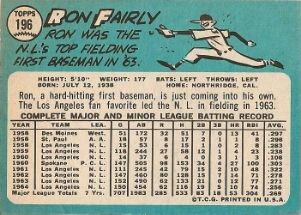
Tuesday, March 26, 2013
#195 Bob Veale
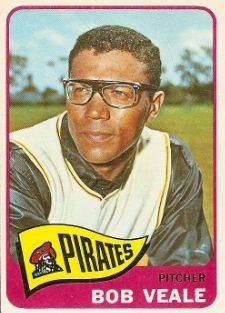
Fun facts about Bob Veale:
-Bob was born in Birmingham, AL and attended Benedictine College in Kansas before signing with the Pirates in 1958.
-Veale was 26 years old when he made the Pirates' Opening Day roster for the first time in 1962. In his second career start (April 22), he earned a complete-game, 4-3 victory against the Mets for his first win.
-1964 was Bob's first full season in the Pittsburgh rotation, and he led the team in practically every pitching category. He was 18-12 with a 2.74 ERA (128 ERA+) and 14 complete games. He also led the National League with 250 strikeouts (edging Bob Gibson on the season's final day), 0.3 HR/9 innings (only 8 in 279.2 innings pitched), and 124 walks allowed. The high strikeout and walk totals and the low home run yield were trends throughout the 6'6" southpaw's career.
-Veale made the first of back-to-back All-Star teams in 1965, when he posted a 17-12 record and a 2.84 ERA. He also established a career high with 276 strikeouts, a total that was dwarfed by Sandy Koufax's otherworldly tally of 382.
-He was a mainstay starter for the Pirates for the seven seasons spanning 1964-1970. During that time, Bob was 103-87 with a 3.01 ERA (115 ERA+).
-The Bucs moved Veale to the bullpen in 1971. The results were gruesome, as his 6-0 record masked a 6.99 ERA. He allowed 36 earned runs in 46.1 innings, and allowed three of the five batters he faced in that year's World Series to reach base.
-He spent the last two seasons and change of his career as a reliever in Boston, retiring after the Red Sox released him in October 1974. In parts of 13 big league seasons, he was 120-95 with a 3.07 ERA.
-Bob is still the Pirates' record-holder with 7.96 strikeouts per 9 innings during his tenure with the club. He is 38th on the all-time MLB list, though several pitchers ahead of him are still active and may drop as they decline.
-Veale spent about a decade after his playing career as a pitching instructor. Among other teams, he worked in the Braves organization.
-He was selected to the Alabama Sports Hall of Fame in 2006 and still lives in Birmingham.
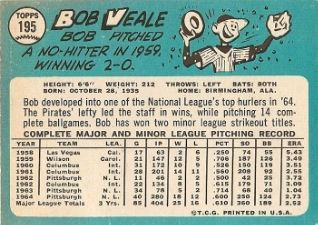
Friday, March 22, 2013
#181 Senators Rookie Stars: Don Loun and Joe McCabe
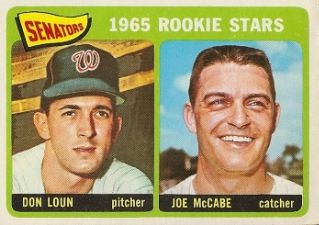
Fun facts about Don Loun:
-Don was born and raised in Frederick, MD, west of Baltimore. He signed with the Senators as an amateur free agent in 1961, when he was 20 years old.
-Despite spending his first two years in Class D ball with Pensacola, Loun was bumped up to Class A in 1963. Pitching for the Peninsula Senators, he went 11-10 with a 3.32 ERA.
-Don continued his sudden rise in 1964, beginning the season at AA York and finishing it with the Senators. After pitching to a 2.14 ERA in 25 games split between York and AAA Toronto, he got a September promotion to the big leagues.
-The young lefty made his debut on September 23, 1964, and it was a dandy. He five-hit the Red Sox for a 1-0 victory, walking none and striking out a pair. Fellow rookie Pete Charton was the hard-luck loser, undone by a second inning in which he gave up three singles and saw the lone run against him score on a double-play grounder. As of this writing, Loun is one of only 44 pitchers to toss a complete game shutout in their first career game.
-His first strikeout victim was future Hall of Famer Carl Yastrzemski.
-Don's second start was not nearly so auspicious. Facing the Red Sox again on October 3 - this time in Fenway Park - he was pulled for a pinch hitter after allowing four runs (three earned) on eight hits and three walks in four innings. He was tagged with the loss as Bill Monbouquette scattered seven hits to top Washington 7-0.
-As fate would have it, those were the only two games of Don Loun's major league career. He was left with a lifetime record of 1-1 and a 2.08 ERA.
-Loun did pitch in the minors through the 1969 season, finishing with a career mark of 52-62 and a 3.99 ERA.
Fun facts about Joe McCabe:
-A native of Indianapolis, IN, Joe attended Purdue University before signing with the original Senators franchise in 1960.
-In his first exposure to AAA, he hit .309 and slugged .509 in 59 games for the Vancouver Mounties in 1962.
-McCabe made it to the major leagues with the Twins (who had moved from Washington to Minnesota) in 1964 and spent the first few months of the season on their roster. He debuted on April 18, entering the game for Earl Battey in the fourth inning and hitting a sacrifice fly in his only plate appearance. He was removed for pinch hitter Jimmie Hall in the eighth inning.
-His first multi-hit game was on May 24 against Milt Pappas and the Orioles. That day, Joe went 2-for-4 with a pair of singles and a run scored, but the O's outlasted the Twins 7-6.
-In his first taste of the majors, McCabe batted .158 (3-for-19) with two RBI in 14 games.
-Joe was traded to the new(er) Senators in October of 1964 for Ken Retzer, another catcher.
-Once again, he started the 1965 season in the big leagues. But once again, he only saw action in 14 games. On the plus side, the backstop did hit his one and only career home run on May 2. It was a solo shot off of Jack Kralick, and gave the Senators a 1-0 lead in a game they pulled out by a 3-2 final.
-McCabe's second (and as it happened, final) big league batting line was .185/.281/.296 with a home run and five RBI.
-He had a cumulative batting average of .174 with a homer and seven RBI over two partial seasons.
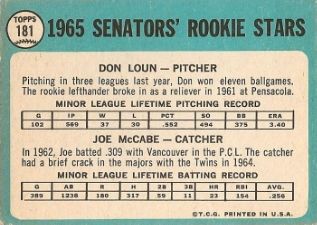
Thursday, March 14, 2013
#175 Bob Aspromonte
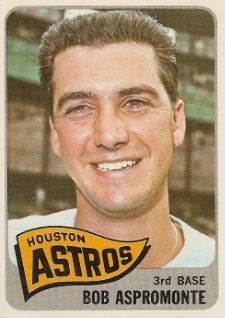
Fun facts about Bob Aspromonte:
-Bob was born in Brooklyn, and signed with the hometown Dodgers in 1956.
-His older brother Ken roamed the infield for the Senators, Indians, and four other clubs (1957-1963), batting .249 in 475 career games.
-Bob played one game for the Dodgers in September of 1956 at age 18, then made it back to stay in 1960. His first home run was hit off of Lew Burdette on May 5, 1960.
-He was tabbed as a starting third baseman by the Houston Colt .45s after they took him in the expansion draft. Leading off for the club in their inaugural game on April 10, 1962, he went 3-for-4 with a walk, a steal, and three runs scored in an 11-2 rout of the Cubs. He's in the trivia books for the first base hit and the first run scored in franchise history.
-Bob had a reputation as a skilled defender at the hot corner. In 1962, he had a streak of 57 consecutive errorless games, a record at the time. He led National League third basemen in fielding percentage in 1964 (.973) and 1971 (.965).
-In 1964, Aspromonte batted .280 with career highs of 12 home runs and 69 RBI.
-On June 10, 1968, there was a national day of mourning following the assassination of Robert F. Kennedy. Aspromonte and teammate Rusty Staub refused to play in that day's scheduled game, and were fined.
-Bob was traded to the Braves after the 1968 season, becoming the last of the original Colt .45s to leave the team. He spent two years in Atlanta and a season with the Mets before retiring in 1971. When he called it quits, he was the last of the Brooklyn Dodgers active in the major leagues.
-In parts of 13 seasons, he batted .252 with 60 home runs and 457 RBI.
-Aspromonte ran a Coors beer distributorship for many years, but is now retired. He still lives in Houston.
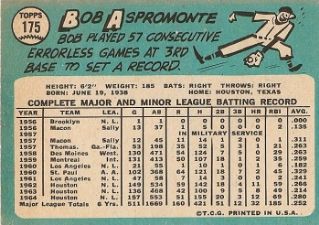
Subscribe to:
Posts (Atom)



